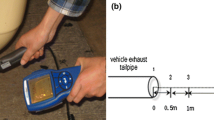Abstract
The vehicle exhaust gas concentration field in the atmosphere of a city block is described by means of solving the system of Euler’s partial differential equations (those of continuity, motion, energy, and state) with the corresponding boundary conditions. The numerical solution is obtained by Davydov’s large particle method. The numerical experiment made it possible to determine the distributions of the main gasdynamic parameters of the gas-air mixture flow and the distribution of the concentration of carbon monoxide entering in the composition of the exhaust gases throughout a three-dimensional domain of complicated shape.
Similar content being viewed by others
References
O.D. Volkova and T.S. Samoilova, “Methodology of the Ecological Rating of Motor Transport Exhaust Impact on Forest Ecosystems,” in: Ecological Standardization. Problems and Methods [in Russian], Moscow (1992), p. 35.
V.I. Tarankov and S.M. Matveev, Effect of Motor Transport Pollution on Pine Stands of the Green Zone of the City of Voronezh [in Russian], Voronezh Forestry Inst., Voronezh (1992).
Yu.G. Feldman, Hygienic Estimation of Motor Transport as a Source of Atmospheric Air Pollution [in Russian], Meditsina, Moscow (1975).
D.P. Chock, “A Simple Line-Source Model for Dispersion near Roadways,” Atm. Environment. Part B 12, 823 (1978).
G.T. Csanady, “Crosswind Shear Effects on Atmospheric Diffusion,” Atm. Environment. Part B 6, 221 (1972).
P.S. Kasibhatla, L.K. Peters, and G. Fairweather, “Numerical Simulation of Transport from an Infinite Line Source: Error Analysis,” Atm. Environment. Part B 22, 75 (1988).
A.K. Luhar and R.S. Patil, “A General Finite Line Source Model for Vehicular Pollution Prediction,” Atm. Environment. Part B 23, 555 (1989).
W.B. Peterson, User’s Guide for HIWAY-2: A Highway Air Pollution Model, EPA-600/8-80-018 (1980).
R. Sivacoumar and K. Thanasekaran, “Line Source Model for Vehicular Pollution Prediction near Roadways and Model Evaluation through Statistical Analysis,” Environ. Pollut. 104, 389 (1999).
M.G. Boyarshinov, “Distribution of Exhaust Gas Concentration near a Roadway with a Random Traffic Stream,” Inzh.-Fiz. Zh. 79(6), 128 (2006).
A.V. Shatrov and K.G. Schwarz, “Numerical Modeling of Atmospheric Mesoscale Processes of Impurity Transport in the Neighborhood of the City of Kirov,” Vych. Mekh. Sploshn. Sred 3(3), 117 (2010).
V.Yu. Petrov, M.Yu. Petukhov, and M.R. Yakimov, Analysis of the Operation Regimes of the Traffic Network of Large Cities with Reference to the Example of the City of Perm [in Russian], Perm Industrial Univ., Perm (2004).
M.G. Boyarshinov, A.V. Kharchenko, and D.S. Balabanov, “Transport and Dispersion by an Airflow of a Heavy Hot Gas,” Vestn. IzhGTU No. 2, 206 (2011).
Yu.M. Davydov (ed.), Numerical Investigation of Topical Problems of Mechanical Engineering and Mechanics of Continuous and Granular Media Using the Large Particle Method. Vols. 1–5 [in Russian], National Academy of Applied Sciences, Moscow (1995).
M.G. Boyarshinov and D.S. Balabanov, “Numerical Modeling of Non-Heat-Conducting Compressible Gas Flow Generated by a Point Source,” Certificate of the State Registration of a computer program No. 2011615085; rights holder GOUVPO PGTU No. 2011613493; date of receipt of application May 12, 2011; date of registration June 29, 2011.
M.G. Boyarshinov and D.S. Balabanov, “Numerical Modeling of Compressible Medium Flow Generated by a Point Source,” Vych. Mekh. Sploshn. Sred 3(3), 18 (2010).
N.V. Smirnov and I.V. Dunin-Barkovskii, Handbook of Probability Theory and Mathematical Statistics for Engineering Applications [in Russian], Nauka, Moscow (1969).
I.G. Filippov, V.G. Gorskii, and T.N. Shvetsova-Shilovskaya, “Dispersion of Impurities in the Ground Layer of the Atmosphere,” Teor. Osn. Khim. Tekhnol. 29, 517 (1995).
A.V. Ruzskii, V.V. Donchenko, V.A. Petrukhin, et al., Methodology of Vehicular Pollution Prediction in City’s Traffic Arteries [in Russian], Ministry of Transport of the Russian Federation, Moscow (1996).
Additional information
Original Russian Text © M.G. Boyarshinov, D.S. Balabanov, 2011, published in Vychislitel’naya Mekhanika Sploshnykh Sred, 2011, Vol. 4, No. 3, pp. 13–20.
Rights and permissions
About this article
Cite this article
Boyarshinov, M.G., Balabanov, D.S. Numericalmodeling of vehicle exhaust gas transport and dispersion by an airflow over a city block. Fluid Dyn 46, 992–999 (2011). https://doi.org/10.1134/S0015462811060172
Received:
Published:
Issue Date:
DOI: https://doi.org/10.1134/S0015462811060172




